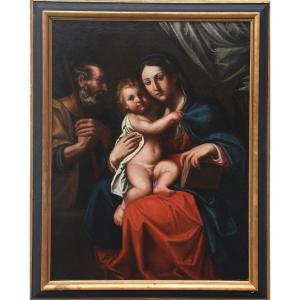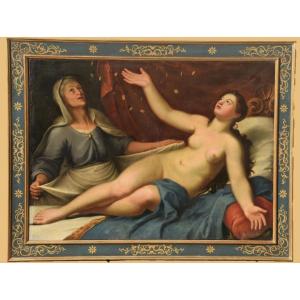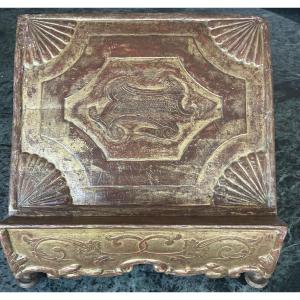OIL ON CANVAS 167 X 133 CM FRANCESCO ALBANI SCHOOL
PROVENANCE: PRIVATE COLLECTION
Francesco Albani or Albano (March 17 or August 17, 1578 - October 4, 1660) Albani was born in Bologna, Italy in 1578. His father was a silk merchant who intended him to go into his own trade. At the age of twelve, however, he had become an apprentice of the competent Mannerist painter Denis Calvaert, in whose studio he had met Guido Reni. He soon followed Reni to the so-called "Accademia" directed by Annibale, Agostino and Ludovico Carracci. This study furthered the careers of many painters of the Bolognese school, including Domenichino, Massari, Viola, Lanfranco, Giovanni Francesco Grimaldi, Pietro Faccini, Remigio Cantagallina and Reni. In 1600 Albani moved to Rome to work on the fresco decoration of the gallery of the Palazzo Farnese, which was being completed by the workshop of Annibale Carracci. In this period Rome, under Clement VIII Aldobrandini (1592–1605) displayed a certain degree of administrative stability and a renewed artistic patronage. While Pope Clement was born to a Florentine family residing in Urbino, his family was allied by marriage with Emilia-Romagna and with the Farnese, since Ranuccio I Farnese, Duke of Parma had married Margherita Aldobrandini. Parma, like Bologna, being part of the Emilia-Romagna region, it was not surprising that Cardinal Odoardo Farnese, Ranuccio's brother, chose to patronize the Bolognese Carracci, thus establishing the Bolognese dominion over the Roman fresco for almost two decades. Albani became one of Hannibal's most important apprentices. Using Annibale's designs and assisted by Lanfranco and Sisto Badalocchio, Albani completed the frescoes for the Chapel of San Diego in San Giacomo degli Spagnoli between 1602 and 1607. In 1606–7, Albani completed the frescoes in the Palazzo Mattei di Giove in Rome. He later completed two more frescoes in the same building, again on the theme of the Life of Joseph. In 1609 he completed the ceiling of a large hall with the Fall of Phaeton and the Council of the Gods for the Palazzo Giustiniani (today Palazzo Odescalchi) in Bassano (di Sutri) Romano. This work was commissioned by Vincenzo Giustiniani, also famous as a patron of Caravaggio. In 1612-14 Albani completed the frescoes of the Choir in the church of Santa Maria della Pace, which had just been remodeled by Pietro da Cortona. In 1616 he painted frescoes on the ceiling of the Apollo and the Seasons at Palazzo Verospi in the Via del Corso for Cardinal Fabrizio Verospi. In his later years, Albani developed a mutual, albeit respectful, rivalry with the more successful Guido Reni, who was also heavily patronized by the Aldobrandinis and under whom Albani had worked at the chapel of the Palazzo del Quirinale. The best frescoes of Albani are those of mythological subjects. Among the best of his sacred subjects are a St. Sebastian and an Assumption of the Virgin, both in the church of San Sebastiano fuori le Mura in Rome. He was among the Italian painters to devote himself to painting cabinet pictures. His mythological subjects include The sleeping Venus, Diana bathing, Danaë reclining, Galatea on the sea and Europa on the bull. A rare etching, the Death of Dido, is attributed to him. Carlo Cignani, Andrea Sacchi, Francesco Mola, and Giovanni Francesco Grimaldi were among his pupils. After his wife's death he returned to Bologna, where he married a second time and lived until his death. THE WORK WILL BE SHIPPED IN A WOODEN CASE AND WILL BE ACCOMPANIED BY A CERTIFICATE OF AUTHENTICITY











































 Le Magazine de PROANTIC
Le Magazine de PROANTIC TRÉSORS Magazine
TRÉSORS Magazine Rivista Artiquariato
Rivista Artiquariato